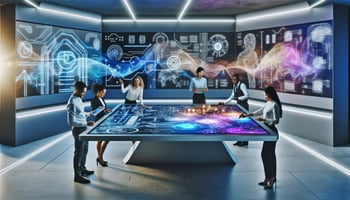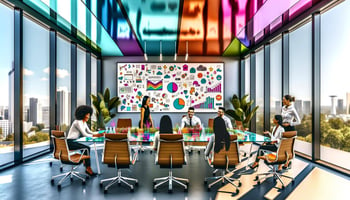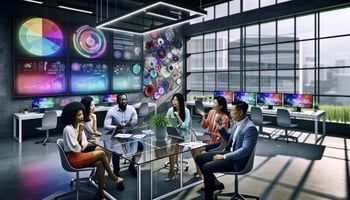The Vision: Merging Artistry with IT In today's world, where technology is often perceived as a...
Technology as an Expression of Art: The IT Revolution and Creativity
The Digital Renaissance: How Technology is Redefining Creativity
How has technology transformed the way we express creativity? This question, once relegated to the realms of science fiction, now stands at the forefront of our daily lives. As the founder of Alqubit, a boutique IT consultancy that views technology as the ultimate expression of art, I've witnessed firsthand the profound impact of the IT revolution on creative industries. Today, we'll explore this digital renaissance and its implications for the future of creativity.
Alqubit: IT as an Expression of Art
The IT Revolution: A New Canvas for Creativity
The IT revolution has fundamentally altered the landscape of creative expression. From digital art and immersive virtual reality experiences to AI-generated music and literature, technology has not just provided new tools for creators - it has redefined the very nature of creativity itself.
In the past, creative industries were largely siloed. Painters painted, writers wrote, and musicians composed. Today, these boundaries are blurring. A modern artist might use machine learning algorithms to generate visual art, incorporate augmented reality into their exhibitions, and distribute their work through blockchain-based platforms. This convergence of technology and creativity is not just changing how we create - it's changing what we create and why we create it.
The Challenge: Adapting to the Speed of Innovation
While the potential of technology in creative fields is immense, it also presents significant challenges. Traditional creative industries often struggle to keep pace with rapid technological advancements. Some of the key challenges include:
- Skill Gap: Many traditional artists and creatives lack the technical skills to fully leverage new technologies.
- Resistance to Change: There's often a fear that technology will replace human creativity, leading to resistance in adopting new tools.
- Ethical Concerns: As AI becomes more prevalent in creative processes, questions arise about authorship, originality, and the value of human creativity.
- Investment Hurdles: Adopting cutting-edge technology often requires significant financial investment, which can be a barrier for individual artists or smaller organizations.
- Rapid Obsolescence: The pace of technological change means that today's cutting-edge tools may be outdated tomorrow, requiring constant learning and adaptation.
At Alqubit, we view these challenges not as obstacles, but as opportunities for innovation and growth. Our approach is to embrace technology not as a replacement for human creativity, but as an extension of it - a new medium through which human ingenuity can express itself.
Technology as a Catalyst for Creativity
Let's explore some concrete examples of how technology is enhancing creativity across various fields:
1. AI in Visual Art
Artificial Intelligence is revolutionizing the world of visual art. Tools like DALL-E and Midjourney are capable of generating stunning images from text descriptions, opening up new possibilities for artists. But rather than replacing human artists, these tools are becoming collaborators in the creative process.
For instance, artist Refik Anadol uses machine learning algorithms to create mesmerizing data sculptures and immersive installations. His work "Machine Hallucinations" processes millions of images of a city to create abstract, flowing visualizations that capture the essence of urban life in a way that would be impossible without AI.
2. Virtual and Augmented Reality in Storytelling
VR and AR are transforming how we tell and experience stories. Filmmakers are using these technologies to create immersive narratives that blur the line between observer and participant.
The New York Times' VR journalism pieces, for example, transport readers to the front lines of global events, creating empathy and understanding in ways that traditional media cannot. In the world of fiction, works like "Wolves in the Walls" combine VR with AI-driven characters to create interactive narratives that respond to the viewer's actions.
3. AI in Music Composition and Production
AI is not just assisting in music production; it's becoming a collaborative partner in the creative process. Tools like AIVA (Artificial Intelligence Virtual Artist) can compose original music in various styles, while platforms like Amper Music allow creators to generate custom soundtracks for their projects.
Grammy-winning artist Taryn Southern's album "I AM AI" was composed and produced in collaboration with AI, showcasing how technology can augment human creativity rather than replace it.
4. 3D Printing in Fashion and Design
3D printing technology is revolutionizing the fashion and design industries. Designers can now create intricate, previously impossible structures and customize products on a mass scale.
Iris van Herpen, a pioneer in 3D-printed fashion, creates otherworldly garments that push the boundaries of what's possible in clothing design. Her work exemplifies how technology can lead to entirely new forms of artistic expression.
5. Blockchain in Art Distribution and Ownership
Blockchain technology, particularly through NFTs (Non-Fungible Tokens), is transforming how digital art is sold, owned, and valued. This technology allows digital artists to create scarcity for their work and provides a new revenue stream for creators.
Artist Beeple's NFT artwork "Everydays: The First 5000 Days" sold for $69 million at Christie's, demonstrating the potential of this technology to revolutionize the art market.
The Alqubit Approach: Technology as an Expression of Art
At Alqubit, we believe that the highest form of technological mastery is indistinguishable from art. Our approach to IT consultancy and services is rooted in this philosophy. We don't just implement technology; we craft digital experiences that are as functional as they are beautiful.
This approach manifests in several ways:
- User Interface Design: We treat every interface as a canvas, creating intuitive, aesthetically pleasing designs that enhance user experience.
- Data Visualization: We transform complex data into visual narratives, making information not just understandable but engaging.
- System Architecture: We approach system design as a form of digital sculpture, creating elegant, efficient structures that are as pleasing to the engineer as they are to the end-user.
- Code Quality: We view clean, efficient code as a form of poetry, where every line serves a purpose and contributes to the overall beauty of the system.
- Problem-Solving: We approach each challenge as an opportunity for creative expression, finding innovative solutions that others might overlook.
This fusion of technology and creativity allows us to deliver solutions that not only meet technical requirements but also inspire and delight users.
The Future of Creativity in the Digital Age
As we look to the future, it's clear that the fusion of technology and creativity will only accelerate. We're on the cusp of several exciting developments:
- Brain-Computer Interfaces: These could allow artists to create directly from their thoughts, opening up entirely new forms of expression.
- Quantum Computing: This could lead to new forms of generative art and music that operate on principles we can barely imagine today.
- Advanced AI Collaborators: As AI becomes more sophisticated, we may see true human-AI creative partnerships, leading to art forms that combine the best of human creativity and machine capabilities.
- Haptic Technology: This could revolutionize how we experience digital art, allowing us to 'feel' virtual creations.
- Biotechnology: The intersection of biotech and art could lead to living artworks that grow and change over time.
At Alqubit, we're not just excited about these possibilities - we're actively working to shape this future. We believe that the most profound innovations will come from the intersection of technology and human creativity.
Conclusion: Embracing the Tech-Creativity Fusion
The IT revolution has ushered in a new era of creativity, one where the boundaries between technology and art are increasingly blurred. This fusion is not about technology replacing human creativity, but about technology extending and enhancing our creative capabilities.
As we've seen, from AI-generated art to blockchain-based ownership models, technology is opening up new avenues for creative expression and distribution. It's allowing us to create things that were previously impossible, to reach audiences in new ways, and to push the boundaries of what we consider art.
At Alqubit, we believe that this tech-creativity fusion is not just the future of art - it's the future of business, of innovation, and of human progress. By viewing technology as an expression of art, we can create solutions that are not just functional, but inspiring. We can solve problems in ways that don't just meet needs, but that excite and delight.
The challenges are significant, from ethical considerations to the need for constant learning and adaptation. But the potential rewards - in terms of new forms of expression, new business models, and new ways of connecting with audiences - are immense.
Your Next Steps: Join the Tech-Creativity Revolution
If you're an IT decision-maker, a business leader, or a creative professional, I invite you to embrace this fusion of technology and creativity. Here's how you can start:
- Assess your current technology stack. Are you using it just for functionality, or are you leveraging it to enhance creativity and user experience?
- Invest in training that bridges the gap between technical and creative skills in your team.
- Experiment with emerging technologies. Even if they don't have an immediate application, they can inspire new ideas and approaches.
- Collaborate across disciplines. Bring together your technical and creative teams to spark innovation.
- Partner with experts who understand both the technical and creative aspects of digital transformation.
At Alqubit, we're committed to helping businesses navigate this exciting intersection of technology and creativity. We offer advanced IT services that don't just meet technical requirements, but that inspire and delight users.
I invite you to visit our website at www.alqubit.net to learn more about our approach and services. Let's work together to create technology solutions that aren't just functional, but truly artistic.
The future belongs to those who can harness both technology and creativity. Are you ready to join the revolution?




